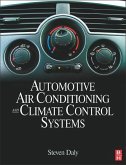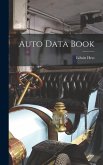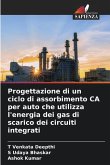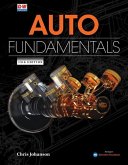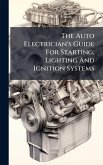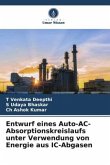Singh
Solar Electric Water and Air Tribrid Auto Engine
Herausgeber: Singh, Chandan Deep; Singh, Rajdeep; Singh, Jasvinder; Singh, Talwinder; Singh, Davinder; Singh, Kanwaljit
Singh
Solar Electric Water and Air Tribrid Auto Engine
Herausgeber: Singh, Chandan Deep; Singh, Rajdeep; Singh, Jasvinder; Singh, Talwinder; Singh, Davinder; Singh, Kanwaljit
- Gebundenes Buch
Andere Kunden interessierten sich auch für
![Automotive Air-Conditioning and Climate Control Systems Automotive Air-Conditioning and Climate Control Systems]() Steven DalyAutomotive Air-Conditioning and Climate Control Systems43,99 €
Steven DalyAutomotive Air-Conditioning and Climate Control Systems43,99 €![Auto Data Book Auto Data Book]() Edwin HessAuto Data Book36,99 €
Edwin HessAuto Data Book36,99 €![Progettazione di un ciclo di assorbimento CA per auto che utilizza l'energia dei gas di scarico dei circuiti integrati Progettazione di un ciclo di assorbimento CA per auto che utilizza l'energia dei gas di scarico dei circuiti integrati]() T Venkata DeepthiProgettazione di un ciclo di assorbimento CA per auto che utilizza l'energia dei gas di scarico dei circuiti integrati39,99 €
T Venkata DeepthiProgettazione di un ciclo di assorbimento CA per auto che utilizza l'energia dei gas di scarico dei circuiti integrati39,99 €![Auto Fundamentals Auto Fundamentals]() Martin W StockelAuto Fundamentals164,99 €
Martin W StockelAuto Fundamentals164,99 €![The Auto Electrician's Guide For Starting, Lighting And Ignition Systems The Auto Electrician's Guide For Starting, Lighting And Ignition Systems]() AnonymousThe Auto Electrician's Guide For Starting, Lighting And Ignition Systems47,99 €
AnonymousThe Auto Electrician's Guide For Starting, Lighting And Ignition Systems47,99 €![Entwurf eines Auto-AC-Absorptionskreislaufs unter Verwendung von Energie aus IC-Abgasen Entwurf eines Auto-AC-Absorptionskreislaufs unter Verwendung von Energie aus IC-Abgasen]() T Venkata DeepthiEntwurf eines Auto-AC-Absorptionskreislaufs unter Verwendung von Energie aus IC-Abgasen60,90 €
T Venkata DeepthiEntwurf eines Auto-AC-Absorptionskreislaufs unter Verwendung von Energie aus IC-Abgasen60,90 €![Digitization and Manufacturing Performance Digitization and Manufacturing Performance]() SinghDigitization and Manufacturing Performance201,99 €
SinghDigitization and Manufacturing Performance201,99 €-
-
-
Produktdetails
- Verlag: Wiley
- Seitenzahl: 256
- Erscheinungstermin: 25. August 2025
- Englisch
- ISBN-13: 9781394166169
- ISBN-10: 1394166168
- Artikelnr.: 69521361
- Herstellerkennzeichnung
- Libri GmbH
- Europaallee 1
- 36244 Bad Hersfeld
- gpsr@libri.de
1 Revolutionizing Transportation: A Comprehensive Review of Electricity-Run
Engines 1
Mukhtiar Singh, Maninder Singh, Harjit Singh, Jasvinder Singh and Mandeep
Singh Rayat
Introduction 2
Importance and Applications of Electricity-Run Engines 3
Conclusion 30
References 31
2 A Review of Water-Run Engines: A Sustainable Solution for Transportation
33
Mukhtiar Singh, Maninder Singh, Harjit Singh, Jasvinder Singh and Mandeep
Singh Rayat
Introduction 34
Theory and Design of Water-Run Engines 35
Working of Water-Run Engine 36
Hydrogen Electrolysis Set Up 37
Fuel Efficiency and Environmental Impact 38
Environmental Impact 41
Practical Applications of Water-Run Engines 42
Benefits 42
Current Developments in Water-Run Engines 43
Future Developments in Water-Run Engines 43
References 44
3 Compressed-Air-Run Engine 45
Minesh Vohra and Arjun Chopra
Introduction 46
Need for Compressed-Air-Run Engine 47
Compressed-Air Energy Technology: Scope, Issues, and Opportunities 47
Various Compressed-Air Engine Parts 48
Working Theory 50
Transmission Aspects of Compressed-Air Engines 52
Outcomes 54
Advantages 54
Disadvantages 55
Applications 56
Conclusion 57
References 57
4 Hybrid Electric Water Engine (Solar Charged) 59
Rajdeep Singh, Chandan Deep Singh and Talwinder Singh
4.1 Introduction 59
4.2 Why Hybrid? 62
4.2.1 How are Hybrid Water Air Solar-Charged Engines Different? 64
4.2.1.1 Hybrid Water Air Engines Will Have Compact Size 65
4.2.1.2 Priority to Safety 65
4.2.1.3 Commercialization of Product 65
4.3 Hybrid Water Air Engine Vehicle Structure 65
4.3.1 Types of Hybrid Engines 67
4.3.1.1 Driveline Topologies 67
4.3.1.2 Hybridization Level 67
4.3.2 Other Types of Hybrid Electric Vehicles 67
4.3.2.1 Plug-In Hybrid Electric Vehicle (PHEV) 68
4.3.2.2 Hybrid Electric Vehicles with In-Wheel Motors 68
4.4 Solar-Charged Hybrid Vehicles 68
4.5 Solar Charging System for Hybrid Engines 73
4.5.1 Types of Solar Cells 73
4.5.1.1 Flexible Solar Panels: Pros and Cons 73
4.5.1.2 Power Management 74
4.6 Conclusions 80
References 81
5 Hybrid Water-Air Engine 85
Rajdeep Singh, Chandan Deep Singh and Talwinder Singh
5.1 Introduction 85
5.2 Technical and Environmental Needs 88
5.3 Concept of Hybrid Water-Air Engines 91
5.3.1 Technology Background 93
5.3.2 Water-Air Hybrid Solution 94
5.3.2.1 Derivative Uses 97
5.3.3 Electronic Control and Measurement 97
5.4 Potential Applications and Societal Values 100
5.4.1 Effect of Water-air Hybrid Engine on Nox Emissions 102
5.4.2 Effect of Water-Air Hybrid Engine on CO and CO2 Emissions 103
5.4.3 Effect of Water-Air Hybrid Engine on HC Emissions 103
5.5 Conclusions 103
References 104
6 Hybrid Electric-Air Engine (Solar Charged) 109
Rajdeep Singh, Chandan Deep Singh and Talwinder Singh
6.1 Introduction 109
6.2 History of Hybrid Air Engines 112
6.2.1 History of Electric Engines (Solar Energy Operated) 114
6.3 Need for Hybrid Air Engines 115
6.3.1 Benefits of Hybrid Air Engines 115
6.4 Concept of Hybrid Air Engines 117
6.4.1 Air Engine Powered by Solar Energy 117
6.4.2 Air Compressors 122
6.4.2.1 Theoretical Modelling of Compressor Mode 122
6.5 Hybrid Solutions 123
6.5.1 The Pneumatic-Combustion Hybrid 123
6.5.2 Air Engine Hybrid 124
6.5.3 Electric and Compressed Air Hybrid Engines 124
6.6 Hybrid Engine Electrical Charged 125
6.6.1 Hybrid Electric Engine Vehicles 126
6.6.1.1 Series Hybrid Engine Vehicles 126
6.6.1.2 Parallel Hybrid Engine Vehicles 127
6.6.1.3 Plug-In Hybrid Electric Engines 128
6.7 Hybrid Air Engines Solar Charged 131
6.8 Conclusions 135
References 136
7 Tribrid Engine 141
Rajdeep Singh and Chandan Deep Singh
Introduction 141
Electric Tribrid Engine 142
Types by Drivetrain Structure 144
References 167
8 Analysis of Hybrid and Tribrid Engines 169
Harjit Singh, Maninder Singh, Mukhtiar Singh and Jasvinder Singh
8.1 Introduction 169
8.2 Design of Hybrid Engine 171
8.3 Design of Tribrid Engine 172
8.4 Operation of Hybrid Engines 173
8.5 Operation of Tribrid Engines 174
8.6 Benefits of Hybrid Engines 175
8.7 Benefits of Tribrid Engines 176
8.8 Conclusion 177
References 178
9 Assessing the Impact of Tribrid Technology on Automobile Performance and
Sustainability 181
Mukhtiar Singh, Harjit Singh, Jasvinder Singh, Maninder Singh and Mandeep
Singh
Introduction 182
Historical Development of Hybrid and Tribid Engines 183
Comparison Between Conventional Combustion Engines and Other Alternative
Powertrain Technologies 184
Types By Drivetrain Structure 187
Series Hybrid 187
Introduction to Tribrid Engine Architectures and Classifications 192
Performance Analysis and Evaluation 196
Performance Metrics for Hybrid and Tribrid Engines 196
Conclusion 208
Key Insights and Implications 209
Suggestions for Further Research 209
References 210
10 Exploring Future Implications for Tribrid Vehicles: Opportunities and
Challenges for Sustainable Transportation 213
Maninder Singh, Mukhtiar Singh, Harjit Singh and Jasvinder Singh
10.1 Introduction 214
10.2 Environmental Implications of Tribrid Vehicle 214
10.3 Energy Efficiency 216
10.4 Battery Technology 217
10.5 Hydrogen Infrastructure 218
10.6 Consumer Adoption 219
10.7 Tribrid Vehicles in Emerging Markets 220
10.8 Government Policies and Incentives for Tribrid Vehicles 220
10.8.1 Tax Incentives 220
10.9 Research and Development Grants 221
10.10 Infrastructure Investment 222
10.11 Subsidies for Fleet Vehicles 223
10.12 Emissions Regulations on Tribrid Vehicle 224
10.13 Rebates for Scrappage of Older Vehicles 225
References 226
Index 229
Engines 1
Mukhtiar Singh, Maninder Singh, Harjit Singh, Jasvinder Singh and Mandeep
Singh Rayat
Introduction 2
Importance and Applications of Electricity-Run Engines 3
Conclusion 30
References 31
2 A Review of Water-Run Engines: A Sustainable Solution for Transportation
33
Mukhtiar Singh, Maninder Singh, Harjit Singh, Jasvinder Singh and Mandeep
Singh Rayat
Introduction 34
Theory and Design of Water-Run Engines 35
Working of Water-Run Engine 36
Hydrogen Electrolysis Set Up 37
Fuel Efficiency and Environmental Impact 38
Environmental Impact 41
Practical Applications of Water-Run Engines 42
Benefits 42
Current Developments in Water-Run Engines 43
Future Developments in Water-Run Engines 43
References 44
3 Compressed-Air-Run Engine 45
Minesh Vohra and Arjun Chopra
Introduction 46
Need for Compressed-Air-Run Engine 47
Compressed-Air Energy Technology: Scope, Issues, and Opportunities 47
Various Compressed-Air Engine Parts 48
Working Theory 50
Transmission Aspects of Compressed-Air Engines 52
Outcomes 54
Advantages 54
Disadvantages 55
Applications 56
Conclusion 57
References 57
4 Hybrid Electric Water Engine (Solar Charged) 59
Rajdeep Singh, Chandan Deep Singh and Talwinder Singh
4.1 Introduction 59
4.2 Why Hybrid? 62
4.2.1 How are Hybrid Water Air Solar-Charged Engines Different? 64
4.2.1.1 Hybrid Water Air Engines Will Have Compact Size 65
4.2.1.2 Priority to Safety 65
4.2.1.3 Commercialization of Product 65
4.3 Hybrid Water Air Engine Vehicle Structure 65
4.3.1 Types of Hybrid Engines 67
4.3.1.1 Driveline Topologies 67
4.3.1.2 Hybridization Level 67
4.3.2 Other Types of Hybrid Electric Vehicles 67
4.3.2.1 Plug-In Hybrid Electric Vehicle (PHEV) 68
4.3.2.2 Hybrid Electric Vehicles with In-Wheel Motors 68
4.4 Solar-Charged Hybrid Vehicles 68
4.5 Solar Charging System for Hybrid Engines 73
4.5.1 Types of Solar Cells 73
4.5.1.1 Flexible Solar Panels: Pros and Cons 73
4.5.1.2 Power Management 74
4.6 Conclusions 80
References 81
5 Hybrid Water-Air Engine 85
Rajdeep Singh, Chandan Deep Singh and Talwinder Singh
5.1 Introduction 85
5.2 Technical and Environmental Needs 88
5.3 Concept of Hybrid Water-Air Engines 91
5.3.1 Technology Background 93
5.3.2 Water-Air Hybrid Solution 94
5.3.2.1 Derivative Uses 97
5.3.3 Electronic Control and Measurement 97
5.4 Potential Applications and Societal Values 100
5.4.1 Effect of Water-air Hybrid Engine on Nox Emissions 102
5.4.2 Effect of Water-Air Hybrid Engine on CO and CO2 Emissions 103
5.4.3 Effect of Water-Air Hybrid Engine on HC Emissions 103
5.5 Conclusions 103
References 104
6 Hybrid Electric-Air Engine (Solar Charged) 109
Rajdeep Singh, Chandan Deep Singh and Talwinder Singh
6.1 Introduction 109
6.2 History of Hybrid Air Engines 112
6.2.1 History of Electric Engines (Solar Energy Operated) 114
6.3 Need for Hybrid Air Engines 115
6.3.1 Benefits of Hybrid Air Engines 115
6.4 Concept of Hybrid Air Engines 117
6.4.1 Air Engine Powered by Solar Energy 117
6.4.2 Air Compressors 122
6.4.2.1 Theoretical Modelling of Compressor Mode 122
6.5 Hybrid Solutions 123
6.5.1 The Pneumatic-Combustion Hybrid 123
6.5.2 Air Engine Hybrid 124
6.5.3 Electric and Compressed Air Hybrid Engines 124
6.6 Hybrid Engine Electrical Charged 125
6.6.1 Hybrid Electric Engine Vehicles 126
6.6.1.1 Series Hybrid Engine Vehicles 126
6.6.1.2 Parallel Hybrid Engine Vehicles 127
6.6.1.3 Plug-In Hybrid Electric Engines 128
6.7 Hybrid Air Engines Solar Charged 131
6.8 Conclusions 135
References 136
7 Tribrid Engine 141
Rajdeep Singh and Chandan Deep Singh
Introduction 141
Electric Tribrid Engine 142
Types by Drivetrain Structure 144
References 167
8 Analysis of Hybrid and Tribrid Engines 169
Harjit Singh, Maninder Singh, Mukhtiar Singh and Jasvinder Singh
8.1 Introduction 169
8.2 Design of Hybrid Engine 171
8.3 Design of Tribrid Engine 172
8.4 Operation of Hybrid Engines 173
8.5 Operation of Tribrid Engines 174
8.6 Benefits of Hybrid Engines 175
8.7 Benefits of Tribrid Engines 176
8.8 Conclusion 177
References 178
9 Assessing the Impact of Tribrid Technology on Automobile Performance and
Sustainability 181
Mukhtiar Singh, Harjit Singh, Jasvinder Singh, Maninder Singh and Mandeep
Singh
Introduction 182
Historical Development of Hybrid and Tribid Engines 183
Comparison Between Conventional Combustion Engines and Other Alternative
Powertrain Technologies 184
Types By Drivetrain Structure 187
Series Hybrid 187
Introduction to Tribrid Engine Architectures and Classifications 192
Performance Analysis and Evaluation 196
Performance Metrics for Hybrid and Tribrid Engines 196
Conclusion 208
Key Insights and Implications 209
Suggestions for Further Research 209
References 210
10 Exploring Future Implications for Tribrid Vehicles: Opportunities and
Challenges for Sustainable Transportation 213
Maninder Singh, Mukhtiar Singh, Harjit Singh and Jasvinder Singh
10.1 Introduction 214
10.2 Environmental Implications of Tribrid Vehicle 214
10.3 Energy Efficiency 216
10.4 Battery Technology 217
10.5 Hydrogen Infrastructure 218
10.6 Consumer Adoption 219
10.7 Tribrid Vehicles in Emerging Markets 220
10.8 Government Policies and Incentives for Tribrid Vehicles 220
10.8.1 Tax Incentives 220
10.9 Research and Development Grants 221
10.10 Infrastructure Investment 222
10.11 Subsidies for Fleet Vehicles 223
10.12 Emissions Regulations on Tribrid Vehicle 224
10.13 Rebates for Scrappage of Older Vehicles 225
References 226
Index 229
1 Revolutionizing Transportation: A Comprehensive Review of Electricity-Run
Engines 1
Mukhtiar Singh, Maninder Singh, Harjit Singh, Jasvinder Singh and Mandeep
Singh Rayat
Introduction 2
Importance and Applications of Electricity-Run Engines 3
Conclusion 30
References 31
2 A Review of Water-Run Engines: A Sustainable Solution for Transportation
33
Mukhtiar Singh, Maninder Singh, Harjit Singh, Jasvinder Singh and Mandeep
Singh Rayat
Introduction 34
Theory and Design of Water-Run Engines 35
Working of Water-Run Engine 36
Hydrogen Electrolysis Set Up 37
Fuel Efficiency and Environmental Impact 38
Environmental Impact 41
Practical Applications of Water-Run Engines 42
Benefits 42
Current Developments in Water-Run Engines 43
Future Developments in Water-Run Engines 43
References 44
3 Compressed-Air-Run Engine 45
Minesh Vohra and Arjun Chopra
Introduction 46
Need for Compressed-Air-Run Engine 47
Compressed-Air Energy Technology: Scope, Issues, and Opportunities 47
Various Compressed-Air Engine Parts 48
Working Theory 50
Transmission Aspects of Compressed-Air Engines 52
Outcomes 54
Advantages 54
Disadvantages 55
Applications 56
Conclusion 57
References 57
4 Hybrid Electric Water Engine (Solar Charged) 59
Rajdeep Singh, Chandan Deep Singh and Talwinder Singh
4.1 Introduction 59
4.2 Why Hybrid? 62
4.2.1 How are Hybrid Water Air Solar-Charged Engines Different? 64
4.2.1.1 Hybrid Water Air Engines Will Have Compact Size 65
4.2.1.2 Priority to Safety 65
4.2.1.3 Commercialization of Product 65
4.3 Hybrid Water Air Engine Vehicle Structure 65
4.3.1 Types of Hybrid Engines 67
4.3.1.1 Driveline Topologies 67
4.3.1.2 Hybridization Level 67
4.3.2 Other Types of Hybrid Electric Vehicles 67
4.3.2.1 Plug-In Hybrid Electric Vehicle (PHEV) 68
4.3.2.2 Hybrid Electric Vehicles with In-Wheel Motors 68
4.4 Solar-Charged Hybrid Vehicles 68
4.5 Solar Charging System for Hybrid Engines 73
4.5.1 Types of Solar Cells 73
4.5.1.1 Flexible Solar Panels: Pros and Cons 73
4.5.1.2 Power Management 74
4.6 Conclusions 80
References 81
5 Hybrid Water-Air Engine 85
Rajdeep Singh, Chandan Deep Singh and Talwinder Singh
5.1 Introduction 85
5.2 Technical and Environmental Needs 88
5.3 Concept of Hybrid Water-Air Engines 91
5.3.1 Technology Background 93
5.3.2 Water-Air Hybrid Solution 94
5.3.2.1 Derivative Uses 97
5.3.3 Electronic Control and Measurement 97
5.4 Potential Applications and Societal Values 100
5.4.1 Effect of Water-air Hybrid Engine on Nox Emissions 102
5.4.2 Effect of Water-Air Hybrid Engine on CO and CO2 Emissions 103
5.4.3 Effect of Water-Air Hybrid Engine on HC Emissions 103
5.5 Conclusions 103
References 104
6 Hybrid Electric-Air Engine (Solar Charged) 109
Rajdeep Singh, Chandan Deep Singh and Talwinder Singh
6.1 Introduction 109
6.2 History of Hybrid Air Engines 112
6.2.1 History of Electric Engines (Solar Energy Operated) 114
6.3 Need for Hybrid Air Engines 115
6.3.1 Benefits of Hybrid Air Engines 115
6.4 Concept of Hybrid Air Engines 117
6.4.1 Air Engine Powered by Solar Energy 117
6.4.2 Air Compressors 122
6.4.2.1 Theoretical Modelling of Compressor Mode 122
6.5 Hybrid Solutions 123
6.5.1 The Pneumatic-Combustion Hybrid 123
6.5.2 Air Engine Hybrid 124
6.5.3 Electric and Compressed Air Hybrid Engines 124
6.6 Hybrid Engine Electrical Charged 125
6.6.1 Hybrid Electric Engine Vehicles 126
6.6.1.1 Series Hybrid Engine Vehicles 126
6.6.1.2 Parallel Hybrid Engine Vehicles 127
6.6.1.3 Plug-In Hybrid Electric Engines 128
6.7 Hybrid Air Engines Solar Charged 131
6.8 Conclusions 135
References 136
7 Tribrid Engine 141
Rajdeep Singh and Chandan Deep Singh
Introduction 141
Electric Tribrid Engine 142
Types by Drivetrain Structure 144
References 167
8 Analysis of Hybrid and Tribrid Engines 169
Harjit Singh, Maninder Singh, Mukhtiar Singh and Jasvinder Singh
8.1 Introduction 169
8.2 Design of Hybrid Engine 171
8.3 Design of Tribrid Engine 172
8.4 Operation of Hybrid Engines 173
8.5 Operation of Tribrid Engines 174
8.6 Benefits of Hybrid Engines 175
8.7 Benefits of Tribrid Engines 176
8.8 Conclusion 177
References 178
9 Assessing the Impact of Tribrid Technology on Automobile Performance and
Sustainability 181
Mukhtiar Singh, Harjit Singh, Jasvinder Singh, Maninder Singh and Mandeep
Singh
Introduction 182
Historical Development of Hybrid and Tribid Engines 183
Comparison Between Conventional Combustion Engines and Other Alternative
Powertrain Technologies 184
Types By Drivetrain Structure 187
Series Hybrid 187
Introduction to Tribrid Engine Architectures and Classifications 192
Performance Analysis and Evaluation 196
Performance Metrics for Hybrid and Tribrid Engines 196
Conclusion 208
Key Insights and Implications 209
Suggestions for Further Research 209
References 210
10 Exploring Future Implications for Tribrid Vehicles: Opportunities and
Challenges for Sustainable Transportation 213
Maninder Singh, Mukhtiar Singh, Harjit Singh and Jasvinder Singh
10.1 Introduction 214
10.2 Environmental Implications of Tribrid Vehicle 214
10.3 Energy Efficiency 216
10.4 Battery Technology 217
10.5 Hydrogen Infrastructure 218
10.6 Consumer Adoption 219
10.7 Tribrid Vehicles in Emerging Markets 220
10.8 Government Policies and Incentives for Tribrid Vehicles 220
10.8.1 Tax Incentives 220
10.9 Research and Development Grants 221
10.10 Infrastructure Investment 222
10.11 Subsidies for Fleet Vehicles 223
10.12 Emissions Regulations on Tribrid Vehicle 224
10.13 Rebates for Scrappage of Older Vehicles 225
References 226
Index 229
Engines 1
Mukhtiar Singh, Maninder Singh, Harjit Singh, Jasvinder Singh and Mandeep
Singh Rayat
Introduction 2
Importance and Applications of Electricity-Run Engines 3
Conclusion 30
References 31
2 A Review of Water-Run Engines: A Sustainable Solution for Transportation
33
Mukhtiar Singh, Maninder Singh, Harjit Singh, Jasvinder Singh and Mandeep
Singh Rayat
Introduction 34
Theory and Design of Water-Run Engines 35
Working of Water-Run Engine 36
Hydrogen Electrolysis Set Up 37
Fuel Efficiency and Environmental Impact 38
Environmental Impact 41
Practical Applications of Water-Run Engines 42
Benefits 42
Current Developments in Water-Run Engines 43
Future Developments in Water-Run Engines 43
References 44
3 Compressed-Air-Run Engine 45
Minesh Vohra and Arjun Chopra
Introduction 46
Need for Compressed-Air-Run Engine 47
Compressed-Air Energy Technology: Scope, Issues, and Opportunities 47
Various Compressed-Air Engine Parts 48
Working Theory 50
Transmission Aspects of Compressed-Air Engines 52
Outcomes 54
Advantages 54
Disadvantages 55
Applications 56
Conclusion 57
References 57
4 Hybrid Electric Water Engine (Solar Charged) 59
Rajdeep Singh, Chandan Deep Singh and Talwinder Singh
4.1 Introduction 59
4.2 Why Hybrid? 62
4.2.1 How are Hybrid Water Air Solar-Charged Engines Different? 64
4.2.1.1 Hybrid Water Air Engines Will Have Compact Size 65
4.2.1.2 Priority to Safety 65
4.2.1.3 Commercialization of Product 65
4.3 Hybrid Water Air Engine Vehicle Structure 65
4.3.1 Types of Hybrid Engines 67
4.3.1.1 Driveline Topologies 67
4.3.1.2 Hybridization Level 67
4.3.2 Other Types of Hybrid Electric Vehicles 67
4.3.2.1 Plug-In Hybrid Electric Vehicle (PHEV) 68
4.3.2.2 Hybrid Electric Vehicles with In-Wheel Motors 68
4.4 Solar-Charged Hybrid Vehicles 68
4.5 Solar Charging System for Hybrid Engines 73
4.5.1 Types of Solar Cells 73
4.5.1.1 Flexible Solar Panels: Pros and Cons 73
4.5.1.2 Power Management 74
4.6 Conclusions 80
References 81
5 Hybrid Water-Air Engine 85
Rajdeep Singh, Chandan Deep Singh and Talwinder Singh
5.1 Introduction 85
5.2 Technical and Environmental Needs 88
5.3 Concept of Hybrid Water-Air Engines 91
5.3.1 Technology Background 93
5.3.2 Water-Air Hybrid Solution 94
5.3.2.1 Derivative Uses 97
5.3.3 Electronic Control and Measurement 97
5.4 Potential Applications and Societal Values 100
5.4.1 Effect of Water-air Hybrid Engine on Nox Emissions 102
5.4.2 Effect of Water-Air Hybrid Engine on CO and CO2 Emissions 103
5.4.3 Effect of Water-Air Hybrid Engine on HC Emissions 103
5.5 Conclusions 103
References 104
6 Hybrid Electric-Air Engine (Solar Charged) 109
Rajdeep Singh, Chandan Deep Singh and Talwinder Singh
6.1 Introduction 109
6.2 History of Hybrid Air Engines 112
6.2.1 History of Electric Engines (Solar Energy Operated) 114
6.3 Need for Hybrid Air Engines 115
6.3.1 Benefits of Hybrid Air Engines 115
6.4 Concept of Hybrid Air Engines 117
6.4.1 Air Engine Powered by Solar Energy 117
6.4.2 Air Compressors 122
6.4.2.1 Theoretical Modelling of Compressor Mode 122
6.5 Hybrid Solutions 123
6.5.1 The Pneumatic-Combustion Hybrid 123
6.5.2 Air Engine Hybrid 124
6.5.3 Electric and Compressed Air Hybrid Engines 124
6.6 Hybrid Engine Electrical Charged 125
6.6.1 Hybrid Electric Engine Vehicles 126
6.6.1.1 Series Hybrid Engine Vehicles 126
6.6.1.2 Parallel Hybrid Engine Vehicles 127
6.6.1.3 Plug-In Hybrid Electric Engines 128
6.7 Hybrid Air Engines Solar Charged 131
6.8 Conclusions 135
References 136
7 Tribrid Engine 141
Rajdeep Singh and Chandan Deep Singh
Introduction 141
Electric Tribrid Engine 142
Types by Drivetrain Structure 144
References 167
8 Analysis of Hybrid and Tribrid Engines 169
Harjit Singh, Maninder Singh, Mukhtiar Singh and Jasvinder Singh
8.1 Introduction 169
8.2 Design of Hybrid Engine 171
8.3 Design of Tribrid Engine 172
8.4 Operation of Hybrid Engines 173
8.5 Operation of Tribrid Engines 174
8.6 Benefits of Hybrid Engines 175
8.7 Benefits of Tribrid Engines 176
8.8 Conclusion 177
References 178
9 Assessing the Impact of Tribrid Technology on Automobile Performance and
Sustainability 181
Mukhtiar Singh, Harjit Singh, Jasvinder Singh, Maninder Singh and Mandeep
Singh
Introduction 182
Historical Development of Hybrid and Tribid Engines 183
Comparison Between Conventional Combustion Engines and Other Alternative
Powertrain Technologies 184
Types By Drivetrain Structure 187
Series Hybrid 187
Introduction to Tribrid Engine Architectures and Classifications 192
Performance Analysis and Evaluation 196
Performance Metrics for Hybrid and Tribrid Engines 196
Conclusion 208
Key Insights and Implications 209
Suggestions for Further Research 209
References 210
10 Exploring Future Implications for Tribrid Vehicles: Opportunities and
Challenges for Sustainable Transportation 213
Maninder Singh, Mukhtiar Singh, Harjit Singh and Jasvinder Singh
10.1 Introduction 214
10.2 Environmental Implications of Tribrid Vehicle 214
10.3 Energy Efficiency 216
10.4 Battery Technology 217
10.5 Hydrogen Infrastructure 218
10.6 Consumer Adoption 219
10.7 Tribrid Vehicles in Emerging Markets 220
10.8 Government Policies and Incentives for Tribrid Vehicles 220
10.8.1 Tax Incentives 220
10.9 Research and Development Grants 221
10.10 Infrastructure Investment 222
10.11 Subsidies for Fleet Vehicles 223
10.12 Emissions Regulations on Tribrid Vehicle 224
10.13 Rebates for Scrappage of Older Vehicles 225
References 226
Index 229


